The double harmonic scale is a world of musical intrigue and diversity, offering a unique blend of Eastern and Western musical traditions.
It can transform your music and bring a fresh feel to your tracks.
So, as a music producer, it’s important to know all about the double harmonic scale to infuse your tracks with unparalleled depth and emotionally resonant music.
As well as stand out in the dynamic world of music production.
In today’s article, we’ll break down:
- What the double harmonic scale is ✓
- The double harmonic major scale ✓
- The double harmonic minor scale ✓
- Role of major seventh & augmented notes ✓
- Chord construction techniques ✓
- Note and interval dissection ✓
- Tone variations and impacts ✓
- Modes within the double harmonic scale ✓
- Diagrams for mastering the scale ✓
- Circle of fifths and semitone structure ✓
- Scale symmetry exploration ✓
- Characteristics of music modes ✓
- Much more ✓
By the end of this article, you’ll have a thorough understanding of the double harmonic scale.
This will enable you to incorporate its unique elements into your music with confidence and creativity.
You’ll be equipped with the knowledge to experiment and innovate like a professional, creating tracks that resonate and showcase your mastery.
So, let’s dive in…
Table of Contents
- What is the Double Harmonic Scale?
- Double Harmonic Major Scale: Breaking it Down
- Exploring the Double Harmonic Minor Scale
- The Intricacies of Major Seventh in Harmonic Scales
- Augmented Variations: Adding Depth to Scales
- Harmonic Scale Chords: Building Blocks of Tone
- Understanding Scale Symmetry
- The Unison Double Harmonic (Byzantine) Advanced Scales MIDI Collection
- Pro Tip: Guitar Techniques for the Double Harmonic Scale
- Double Harmonic Scale: Final Thoughts
What is the Double Harmonic Scale?
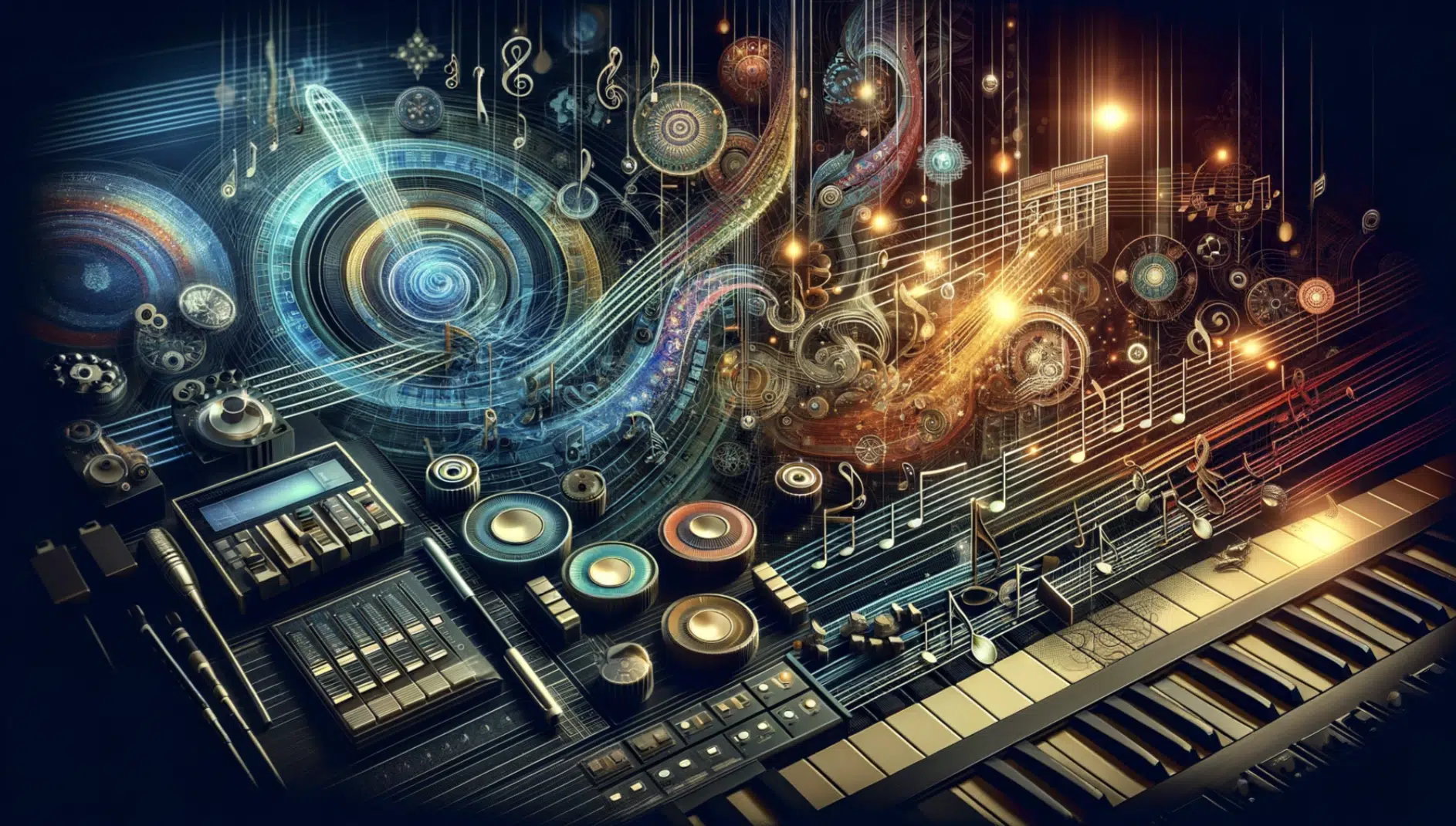
The double harmonic scale, a treasure in the world of music scales, stands out with its unique combination of notes and intervals.
This scale, often referred to as the Byzantine scale, offers a distinct sound that has colored various musical genres.
It’s characterized by an augmented second between the second and third notes, which sets it apart from the more familiar major and minor scales.
At its core, the double harmonic scale is built on a sequence of notes that create a sound rich in cultural heritage.
This scale, comprising seven notes, is often associated with Middle Eastern music but has found its way into Western compositions.
It offers a blend of:
- Exotic tones
- Traditional melodies
The key to understanding this scale lies in its note pattern 一 which offers a mix of augmented, major, and minor intervals.
For digital music producers, the double harmonic scale opens up a realm of creative possibilities.
By incorporating this scale into your compositions, you can add a unique flavor that sets your music apart.
Double Harmonic Major Scale: Breaking it Down
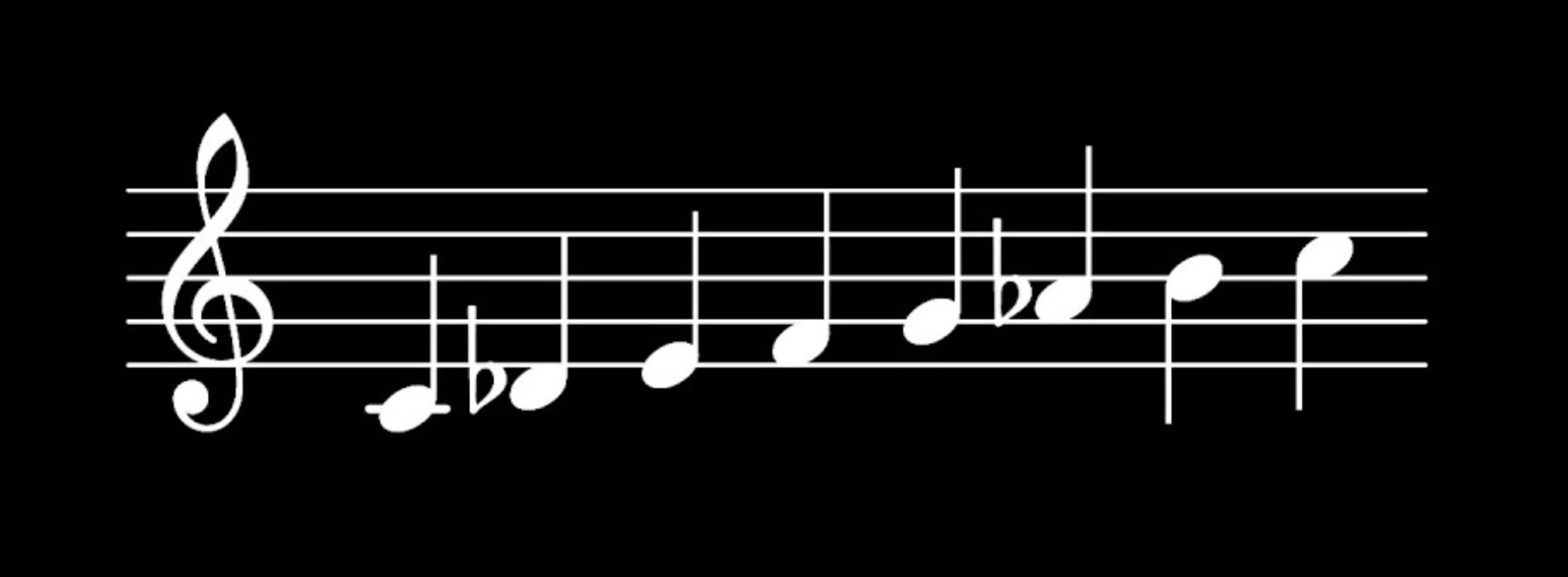
The double harmonic major scale is a variant of the double harmonic scale that emphasizes major intervals and tones.
This scale is built by altering the traditional major scale with specific augmented and minor intervals, creating a sound that is both familiar and intriguingly different.
The double harmonic major scale is a fusion of the classic major scale’s brightness with the exotic touch of Eastern music traditions.
In the double harmonic major scale, the augmented second interval plays a pivotal role.
This interval, particularly noticeable between the second and third notes of the scale, E and F in a C double harmonic major scale, brings a dramatic quality to the music.
This unique feature is what sets the double harmonic major scale apart from the standard major scale.
This makes the double harmonic major scale an excellent tool for adding a distinctive sound to your tracks.
Utilizing the double harmonic major scale in music production isn’t just about the notes themselves.
It’s about how these notes interact to create a specific mood and atmosphere with the double harmonic major scale.
For instance, the tension and release created by the augmented second can be used to build suspense in a track or to add a layer of emotional depth.
It’s this interplay of notes that makes the double harmonic major scale a valuable asset in a digital music producer’s toolkit.
Exploring the Double Harmonic Minor Scale
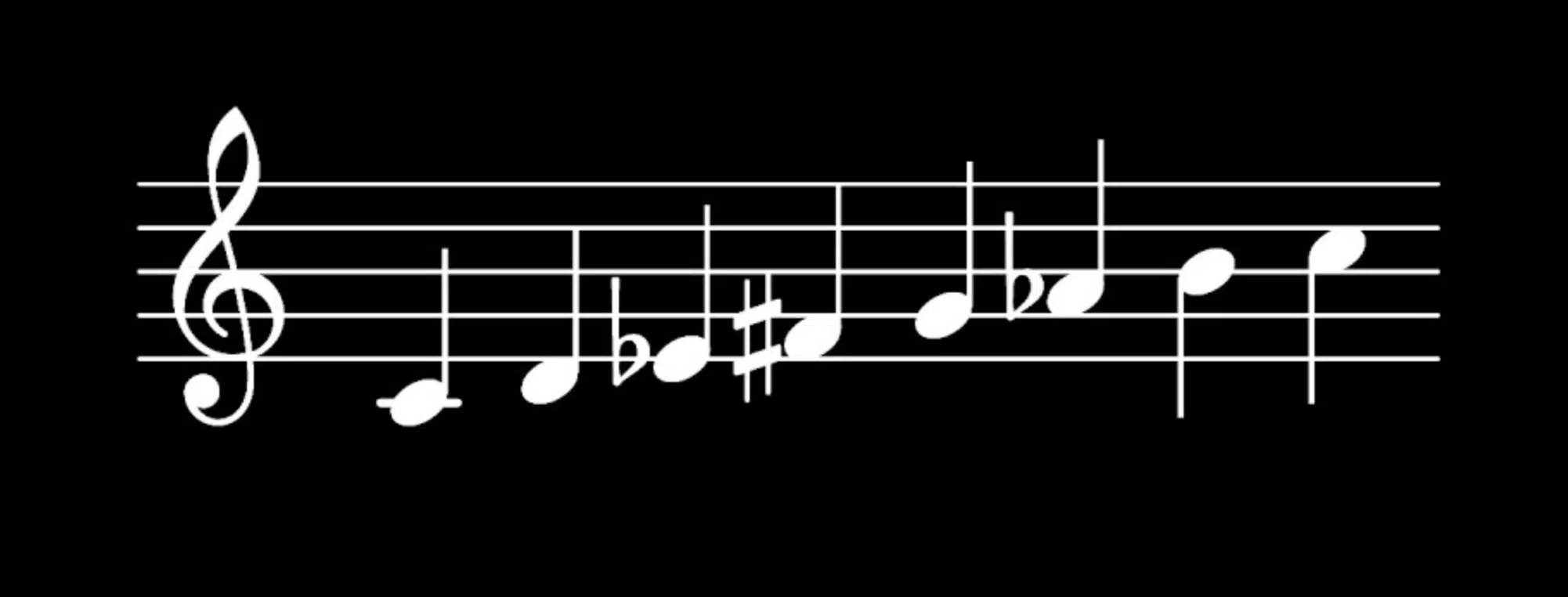
While the double harmonic major scale leans towards a brighter, major tone, the double harmonic minor scale offers a different palette.
The double harmonic minor scale, though similar (not identical) in its construction to the double harmonic major, focuses more on minor intervals and tones.
This gives it a deeper, more introspective sound.
The double harmonic minor scale is particularly effective in creating moods that are emotionally rich.
The construction of the double harmonic minor scale involves a careful balance of:
- Minor intervals
- Major intervals
- Augmented intervals
The presence of the augmented second, just like in the major variant, adds a unique twist to the scale 一 offering a blend of Western and Eastern musical influences.
This scale is a testament to the versatility of the double harmonic concept, adaptable yet distinct in both its major and minor forms.
For music producers, the double harmonic minor scale can be a source of inspiration, especially when looking to infuse their music with a sense of drama and depth.
This scale works exceptionally well in genres that thrive on emotional expression, such as cinematic music or electronic beats.
The key to harnessing the power of this scale lies in understanding how its unique intervals can be used to evoke specific emotions and atmospheres.
The Intricacies of Major Seventh in Harmonic Scales

A crucial element in the world of harmonic scales, including the double harmonic scale, is the major seventh interval.
This interval, representing a significant leap from the root note to the almost-octave, adds a sense of completion and sophistication to the scale.
In the context of the double harmonic scale, the major seventh plays a pivotal role in defining the scale’s character.
This provides a bridge between the exotic augmented seconds and the more familiar sounds of Western music.
The major seventh, especially in the double harmonic scale, can be both challenging and rewarding for music producers.
This interval demands attention due to its tension and potential for resolution 一 making it a powerful tool in musical storytelling.
Whether it’s used in a climactic moment of a song or as a subtle undercurrent, the major seventh adds a layer of complexity and emotional depth to the music.
Understanding the interplay between the major seventh and other intervals within the double harmonic scale is key to mastering its use in music production.
Augmented Variations: Adding Depth to Scales

Augmented notes play a vital role in the uniqueness of the double harmonic scale.
These notes, which involve raising a note by a half step, contribute to the exotic and unconventional sound of the scale.
In the realm of the double harmonic major and minor scales, augmented notes create a tension that is:
- Intriguing
- Captivating
- Challenging
It offers a distinct contrast to the more predictable patterns of major and minor scales.
The incorporation of augmented notes in the double harmonic scale is not just a matter of adding complexity…
It’s about creating a sonic landscape that is rich and multi-dimensional.
For digital music producers, understanding how to use these augmented notes effectively is key to crafting music that resonates with depth and originality.
Whether it’s through the use of augmented chords or by incorporating augmented intervals in melodies, these notes can be a powerful tool in a producer’s arsenal, just like distortion.
Harmonic Scale Chords: Building Blocks of Tone
The harmonic scale, particularly the double harmonic scale, offers a rich foundation for building chords that resonate with unique tonal qualities. Let’s dive in.
-
Constructing Chords within the Double Harmonic Scale

Constructing chords within the double harmonic scale is an art that requires a deep understanding of its unique intervallic song structure.
This scale, with its blend of augmented, major, and minor intervals, provides a canvas for creating chords that are rich in texture and emotional depth.
For music producers, mastering chord construction in this scale is essential for exploiting its full potential in music production.
The process of creating chords within the double harmonic scale involves exploring combinations of notes that highlight the scale’s distinct qualities.
This might include the use of:
- Augmented seconds 一 To add a sense of drama.
- The major seventh 一 To add some emotional pull.
By examining the relationship between two triads in the double harmonic scale, you can observe a diminished step, notably between E-F. And, in chord progressions like ii iii iv, it offers a unique harmonic richness.
The chords formed within this scale are not just collections of notes.
They are expressions of the scale’s unique character, capable of evoking a wide range of emotions in the listener.
-
Dissecting The Notes and Intervals in the Double Harmonic Scale
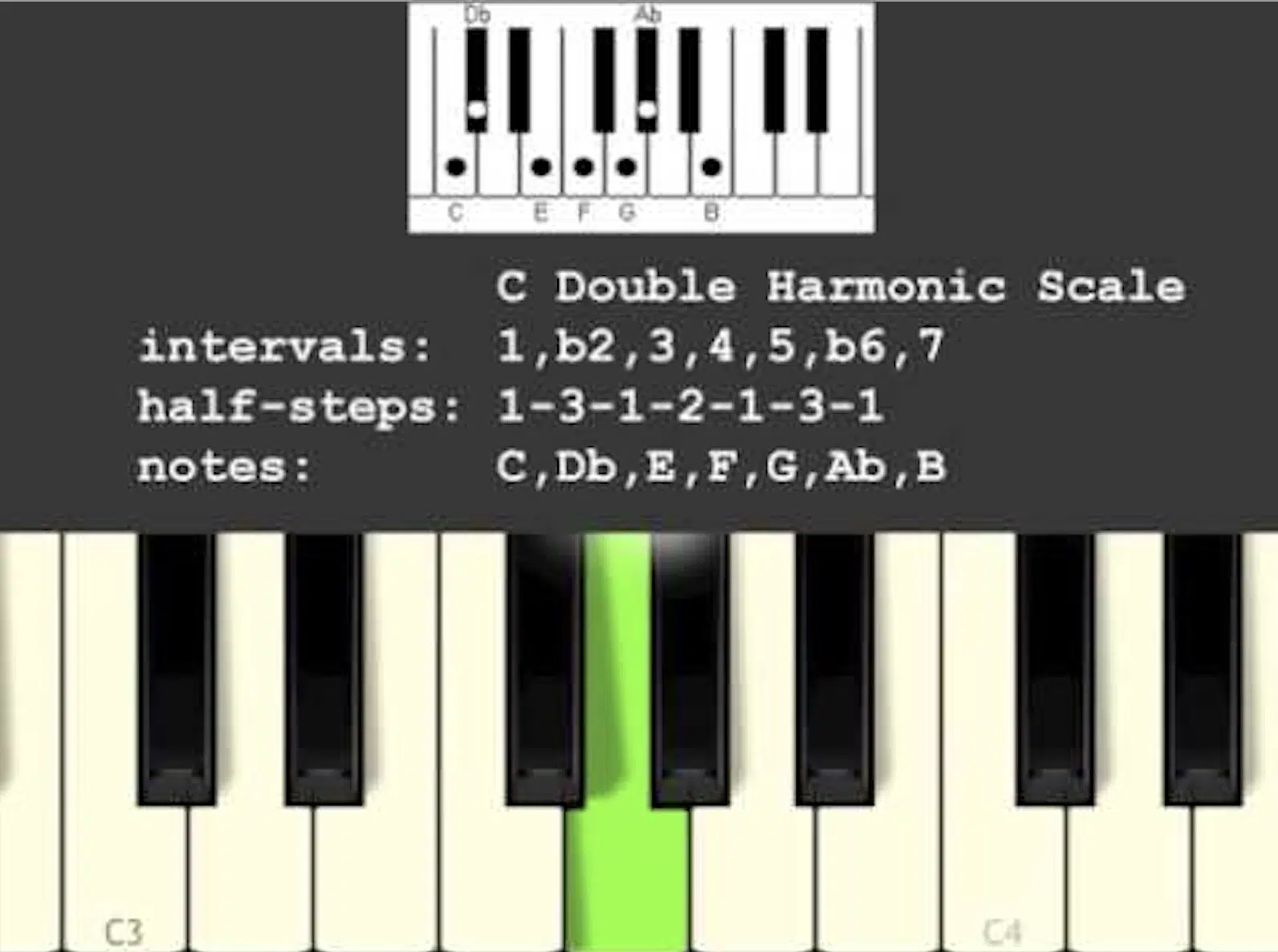
The double harmonic scale is a fascinating amalgamation of notes and intervals that create its distinctive sound.
At its root, this scale comprises seven notes, each contributing to its unique character.
In the key of C, for instance, the scale is formed by the notes:
- C (the root)
- Db (a flattened second)
- E (the major third)
- F (the perfect fourth)
- G (the perfect fifth)
- Ab (the minor sixth)
- B (the major seventh)
This particular arrangement of notes, especially the flattened second and the major seventh, gives the double harmonic scale its exotic and tension-filled sound.
The intervals within the double harmonic scale are key to its unique musical expression.
The scale features a mix of half steps, whole steps, and augmented seconds 一 creating a distinctive melodic and harmonic texture.
The most notable interval is the augmented second between D and E, and again between Ab and B.
NOTE: This is rare in Western music but pivotal in creating the scale’s Eastern flavor.
This augmented second, along with the minor sixth and major seventh intervals, contributes to the scale’s dramatic and often haunting quality.
-
Tone Variation and Its Impact
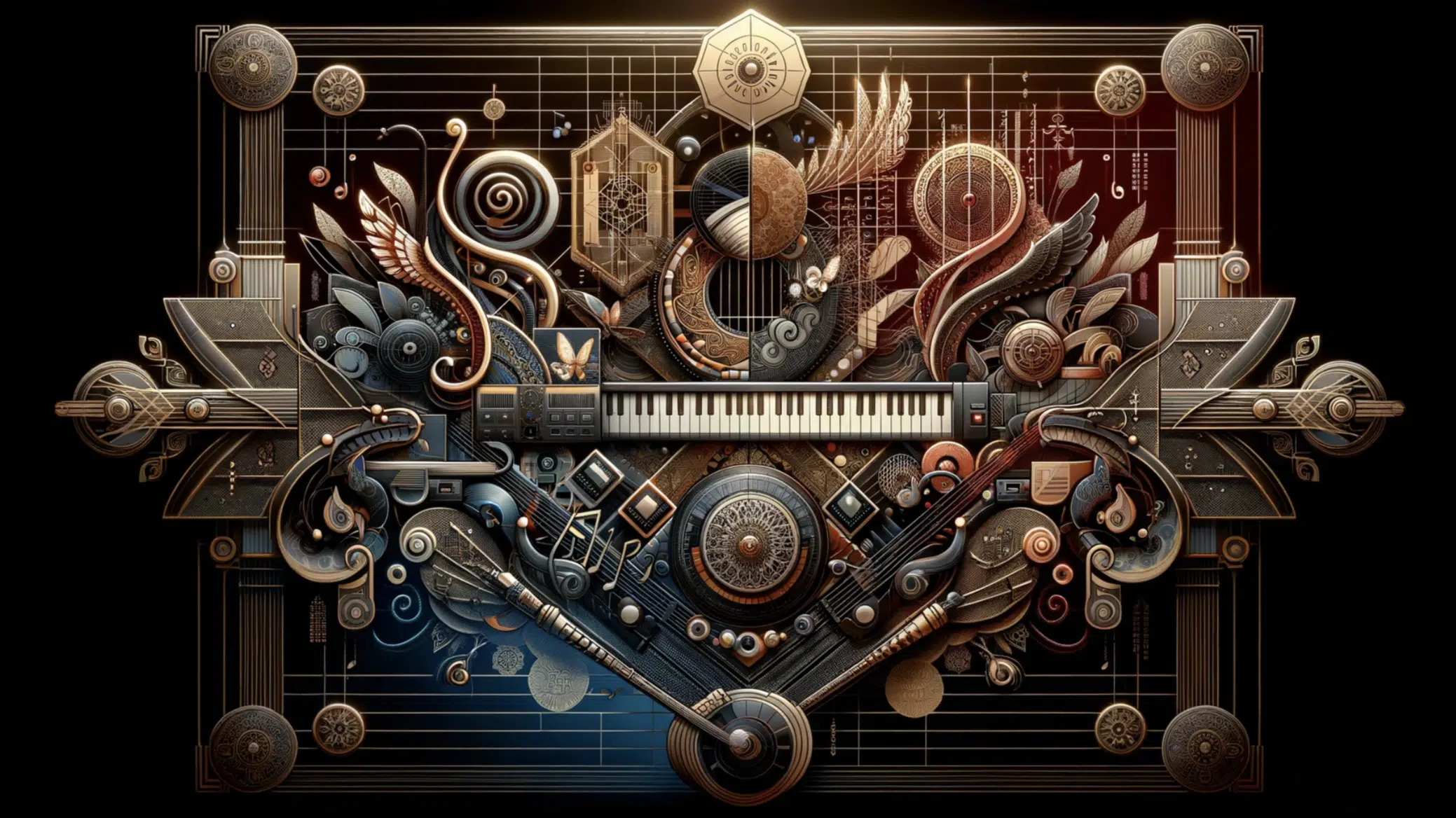
Tone variation in the double harmonic scale adds another layer of complexity and creativity to music production and artistry.
This scale, with its unique intervals, offers a wide range of tonal possibilities, like:
- The flattened second & minor sixth 一 bringing a dark, brooding sound.
- The major third & perfect fifth 一 bringing a resonant, familiar sound.
These variations in tone allow digital music producers to craft compositions that are proper, dynamic, and emotionally charged.
The impact of tone variation within the double harmonic scale is significant.
It allows composers and producers to create a narrative within their music, using the scale’s tonal diversity to evoke specific emotions and atmospheres.
For instance, the tension created by the augmented second can be used to build suspense or express longing.
While the resolution provided by the major seventh can convey a sense of completeness and satisfaction.
By experimenting with different combinations of notes, you can discover new ways to express yourself musically.
-
Exploring Different Modes within the Double Harmonic Scale
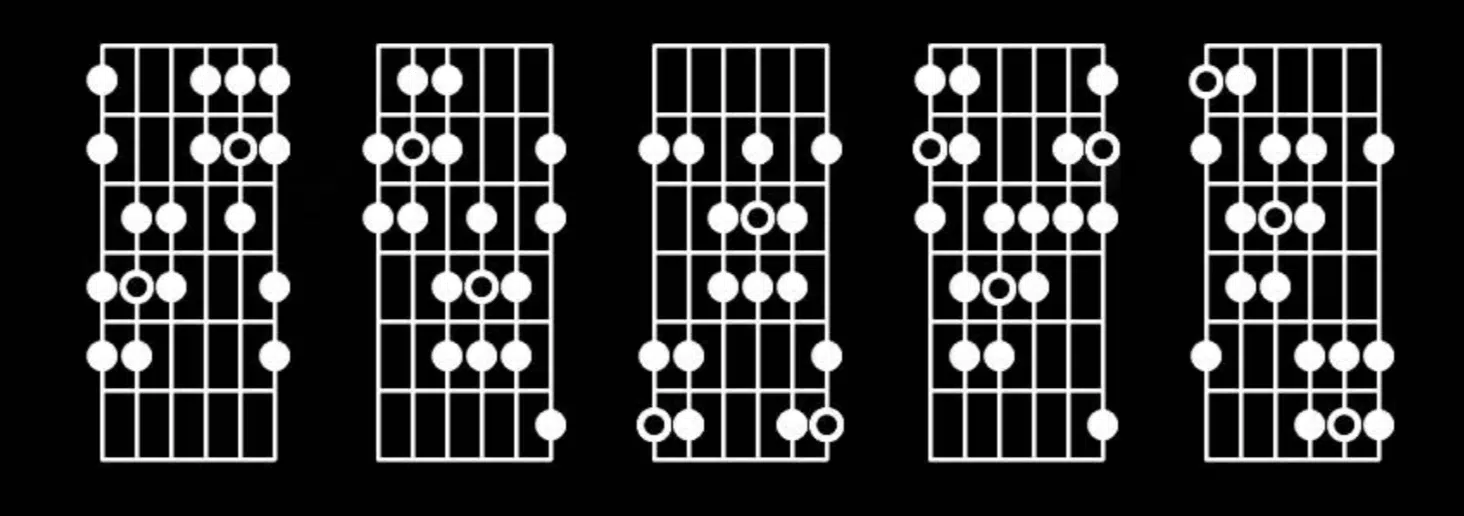
The double harmonic scale offers a plethora of modes, each with its unique set of intervals and tones.
These modes, derived from the primary scale by starting on different notes, provide a rich variety of sonic landscapes for music production.
The Byzantine mode is the most well-known mode of the double harmonic scale.
It begins on the second note of the scale and emphasizes the augmented second interval, a hallmark of this scale’s exotic sound.
Each mode of the double harmonic scale, be it the Byzantine, Hungarian minor (the 4th mode of the double harmonic scale), or others, presents unique opportunities for harmonic and melodic exploration.
The exploration of these modes, like the Byzantine, Hungarian minor, etc., is not just an academic exercise.
It’s a practical tool for digital music producers.
Each mode within the double harmonic scale can be used to evoke different emotions and atmospheres in music.
For instance, the harmonic minor mode, another variant of this scale, offers a different feel compared to the major or Byzantine modes.
-
Utilizing Diagrams: Circle of Fifths and Semitones
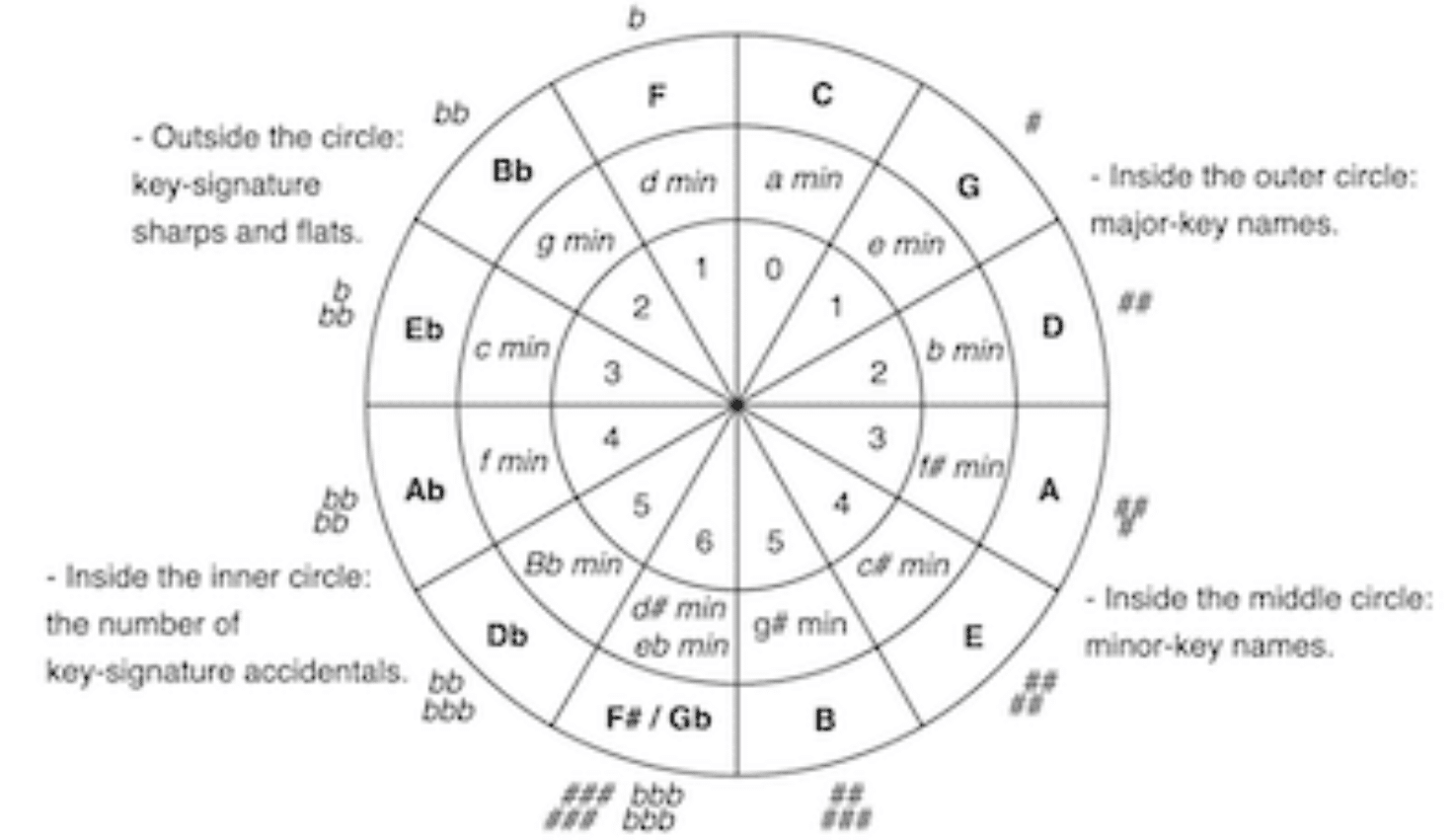
The circle of fifths is one of the most crucial diagrams for understanding the double harmonic scale.
This is particularly true in terms of key relationships and modulation possibilities.
This diagram illustrates how different keys are interconnected, showing the progression from one key to the next through fifths.
For the double harmonic scale, the circle of fifths helps in identifying compatible keys and modes, facilitating smooth transitions and modulations within compositions.
Semitones (or half steps) are integral to the structure of the double harmonic scale, especially in defining its characteristic intervals.
The scale’s augmented seconds, which are essentially a sequence of two semitones, create its distinctive sound.
Understanding the placement and impact of these semitone patterns within the scale is essential for digital producers.
This knowledge allows for the effective use of tension and resolution 一 the difference between a boring and epic beat.
Understanding Scale Symmetry
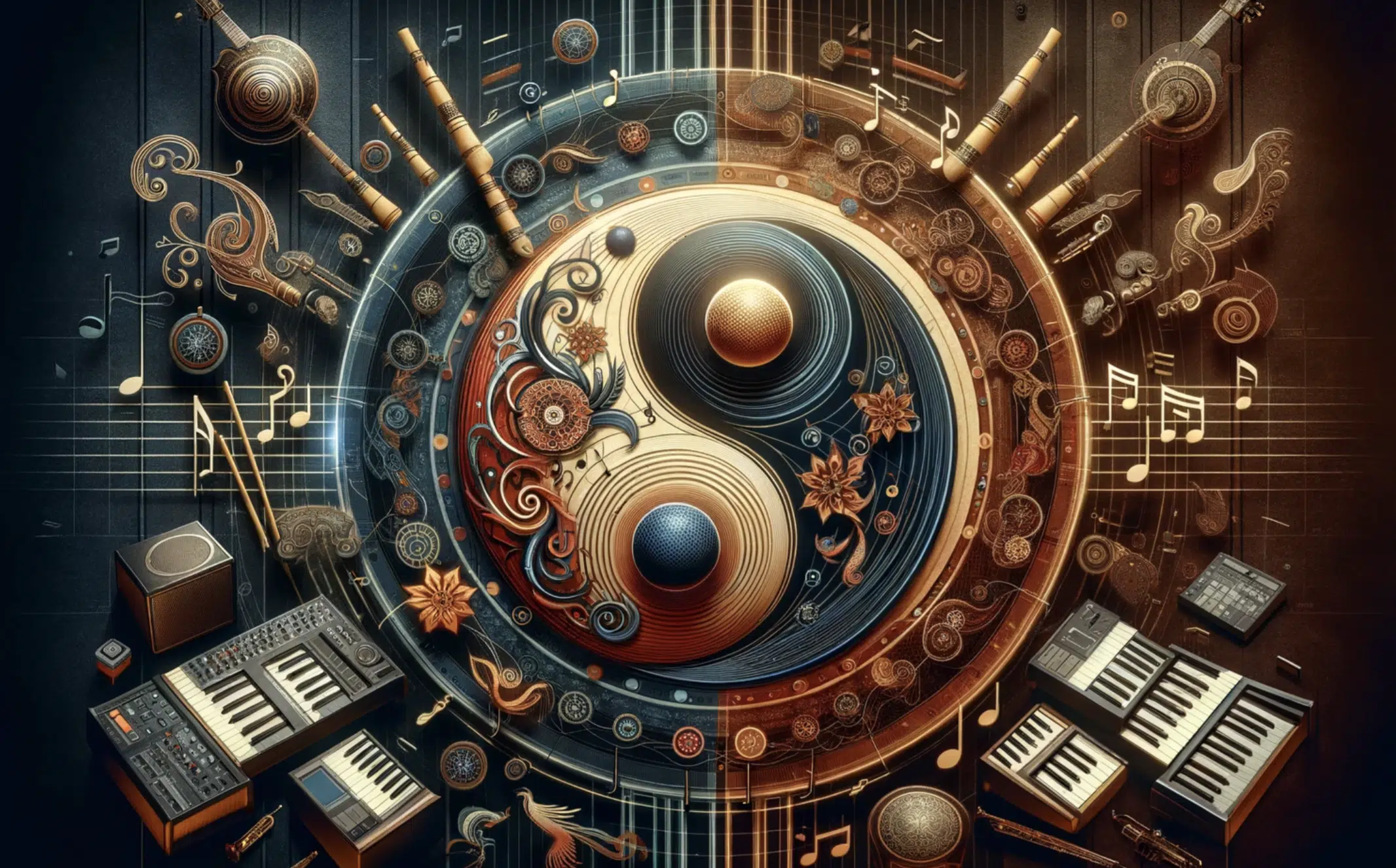
The double harmonic scale is not only about its notes and intervals but also about the symmetry and modes that define its musical structure.
Scale symmetry in the double harmonic scale is a fascinating aspect that contributes to its musical allure.
This symmetry is observed in the way the intervals mirror each other around a central axis, creating a perfectly balanced yet intriguing structure.
For example, in the C double harmonic scale, the intervals between the notes C-D and G-Ab are both augmented seconds 一 reflecting a symmetrical pattern.
This symmetry not only adds to the aesthetic appeal of the scale but also provides a framework for producers to create cohesive and harmonically balanced tracks.
The symmetrical nature of the double harmonic scale offers a unique approach to melody and harmony construction.
By understanding this symmetry, music producers can play melodies that exploit the scale’s balanced structure.
It creates musical phrases that are both memorable and harmonically satisfying.
The Unison Double Harmonic (Byzantine) Advanced Scales MIDI Collection
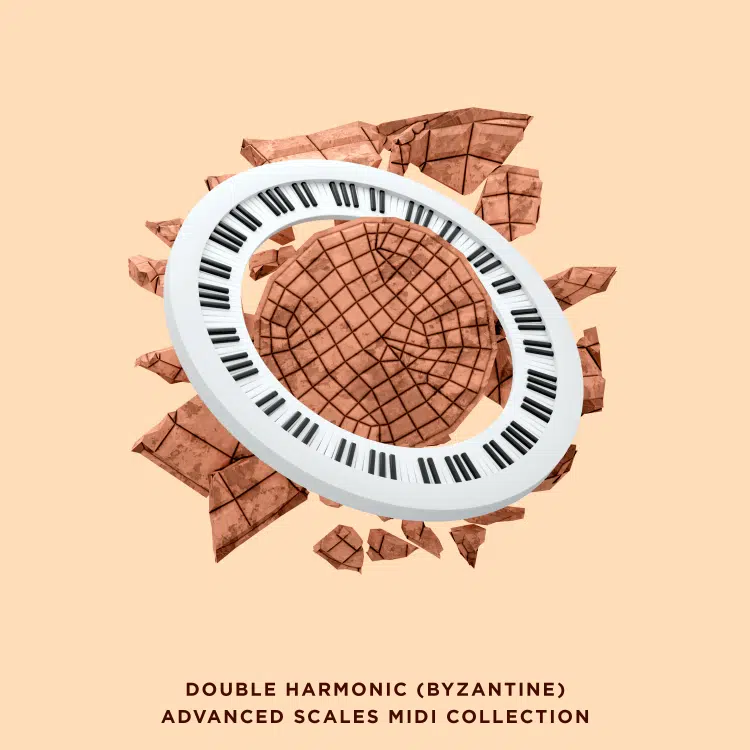
The Unison Double Harmonic (Byzantine) Advanced Scales MIDI Collection is an exceptional tool for music producers aiming to master the double harmonic scale.
This comprehensive pack provides over 1,100 MIDI files, including:
- Scales
- Chords
- Progressions
- Melodies
They are all specifically tailored to the double harmonic scale.
Notably used in tracks by Deep Purple, Opeth, and famously in the opening theme of Pulp Fiction, this pack is a treasure trove for those seeking to create music with a rare, dark quality.
This MIDI collection is designed to simplify the music production process 一 eliminating the need to spend years learning music theory.
With its versatile MIDI format, the pack allows for easy integration and customization within your projects.
Whether you’re creating leads, plucks, pads, keys, or arpeggios, this collection offers instant inspiration and a foundation for quickly starting and finishing tracks.
By using this pack, you’ll stand out from other producers by incorporating exotic scales and patterns usually reserved for the top echelon of music production.
The “Unison Double Harmonic (Byzantine) Advanced Scales MIDI Collection” is your gateway to creating high-quality, attention-grabbing music with the unique sound of the double harmonic scale.
Download This Invaluable Pack Now!
Pro Tip: Guitar Techniques for the Double Harmonic Scale

Guitar playing techniques for the double harmonic scale involve a combination of skillful finger placement and creative expression.
The unique intervals of this scale (particularly the augmented seconds) require guitar players to adapt their playing style to navigate the scale efficiently.
This might involve unusual finger stretches or picking patterns, especially when playing the scale across multiple octaves.
Mastering these techniques allows guitar players to fully explore the expressive potential of the double harmonic scale.
Beyond technical proficiency, guitar players can experiment with various playing techniques represented to bring out the distinct qualities of the double harmonic scale.
This could include the play of:
- Hammer-ons
- Pull-offs
This will emphasize the scale’s exotic intervals.
Or, experimenting with different strumming and plucking patterns to highlight its rhythmic possibilities.
The double harmonic scale offers guitar players a unique opportunity to expand their musical vocabulary.
This way, guitar players can incorporate sounds and styles that are traditionally outside the realm of Western music.
Double Harmonic Scale: Final Thoughts
The double harmonic scale is more than just a series of notes; it’s a gateway to a rich and diverse musical universe.
With its unique blend of Eastern and Western musical traditions, the double harmonic scale offers various creative possibilities for music producers.
Whether it’s the exotic sound of the double harmonic major scale or the emotional depth of the double harmonic minor scale, this scale is a tool that can elevate your music to new heights.
The double harmonic scale, with its augmented notes and major sevenths, challenges and inspires you to think outside the conventional boundaries.
Its versatility in tone and mood makes it suitable for a wide range of genres, adding a unique flavor to each composition.
As you apply the knowledge and techniques shared in this article, remember that the double harmonic scale isn’t just a theoretical concept; it’s a canvas for your creativity.
So, embrace the double harmonic scale in your music production journey and let it guide you to create compositions that resonate with originality and cultural richness.
Until next time…







Leave a Reply
You must belogged in to post a comment.